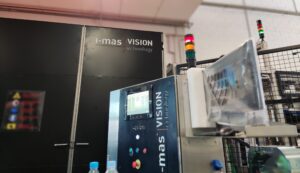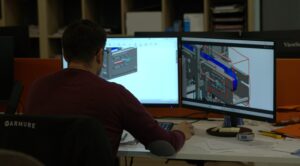The integration of robots into production lines is no longer a futuristic trend but an essential reality in today’s industry. Whether to improve efficiency, reduce costs or increase precision, robots play a key role in optimizing production processes.
However, to achieve a successful implementation, it is crucial to take into account certain technical and operational factors.
In this article, we share 5 key tips that will help you integrate robots into your production line efficiently and smoothly.
Benefits of robot integration
Increased efficiency
The integration of robots into production lines enables a significant improvement in the speed and accuracy of tasks, surpassing the capabilities of human labor. This translates into reduced operating costs and better optimization of resources, as robots can work continuously and with a smaller margin of error.
Improved product quality
Robots help minimize errors and variability in production, ensuring greater consistency in final products. In addition, they enable compliance with the most demanding quality standards, reducing defects and improving quality control at every stage of the production process.
Occupational safety
Some tasks can be hazardous for workers due to repetitive movements, exposure to toxic environments or extreme temperatures, or potential health risks. In these cases, robots play a crucial role by taking over these functions, protecting employees from accidents or even illness and improving working conditions.
How to integrate robotics into the manufacturing process successfully?
Tip 1: Analyze your needs and define your goals
The first step in implementing robots on a production line is to understand the current challenges and opportunities that automation can offer. Identify weak points, repetitive or dangerous tasks for employees, and set clear goals to solve those problems. It is critical to evaluate the costs and benefits that robotics will bring to your business and how you will measure the success of this integration.
Tip 2: Select the right robot and the right tools
It is important to choose the type of robot and the tools that best suit the needs of your production process. There are industrial, collaborative and mobile robots, each with specific characteristics. In addition, you will have to evaluate the additional components such as sensors, controllers and software, ensuring their compatibility and the safety of the system.
Finally, don’t forget to consider technical support and maintenance to ensure long-term use.
Tip 3: Design the workflow and layout of your plant.
Incorporating robots requires adapting the physical layout of the plant and organizing the workflow so that the robots operate as efficiently as possible. It is essential to plan how they will interact with the rest of the equipment and personnel, ensuring that there is a smooth sequence of operations. A well-structured design will reduce waste and downtime, maximizing productivity.
Tip 4: Perform extensive testing
Once you have selected the right equipment, the next step is to integrate it into your system and perform tests to confirm that everything works as it should. Configure the robots and test them in different operational situations.
On the other hand, make sure that all personnel involved receive the necessary training to work with the new system efficiently and safely.
Tip 5: Continually monitor for system improvement.
After implementation, it is essential to monitor the performance of the robotic system. Collect data on production, quality and efficiency to identify potential areas for improvement. Make adjustments when necessary and keep the robots in top condition with regular maintenance. In addition, staying on top of technological innovations will allow you to keep improving your production line.
Robot integration in i-mas
At i-mas, we are committed to transforming the industry through innovative solutions that integrate advanced robotics into our customers’ production lines. We have more than 20 years of experience in the implementation of industrial automation, machine vision and deep learning technologies, which allows us to offer solutions tailored to the specific needs of each project.
Our systems allow not only to increase production efficiency and quality, but also to ensure a safer working environment, minimizing risks and maximizing operational performance.
Want to learn more about our services? Get in touch with us!



